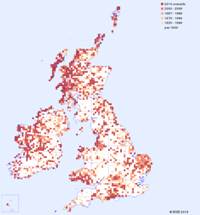The Early Marsh-orchid is one of our most beautiful and enigmatic wild orchids. The flowers occur in four colours, and they are sufficiently different from one another to have all been given subspecies status: a pale salmon pink, Dactylorhiza incarnata subsp. incarnata; brick red, Dactylorhiza incarnata subsp. coccinea; purple, Dactylorhiza incarnata subsp. pulchella; and cream Dactylorhiza incarnata subsp. ochroleuca. The latter is confined to the East Anglian fens. In favoured habitats Dactylorhiza incarnata can carpet the ground in early spring, and in most good sites it is easy to find two or more of the subspecies growing in close proximity. In addition to the above there is also another subspecies. Sometimes called the Flecked Marsh-orchid or Leopard Orchid, Dactylorhiza incarnata subsp. cruenta is known only from part of western Ireland and a few sites in Scotland; it is classified as Endangered in the UK, while in Ireland, where it mainly occurs in The Burren, it is also under threat from habitat degradation. Early Marsh-orchid in all its variations flowers between mid May and late June. The subspecies which occur in England, Scotland and Wales are localised but can be abundant in good years. With the exception of Dactylorhiza incarnata subsp. pulchella (which is tolerant of more acid conditions and occurs in bogs and on heathland), these orchids favour alkaline substrates and can be found in fens, wet alkaline meadows and sand-dune slacks. On the European mainland, Dactylorhiza incarnata is recorded from Scandinavia in the north to Italy and Spain in the south.
| Distribution Map | Key Features | |
 |
Records for the Early Marsh-orchid from BSBI are shown on the map with most recent in front. (Hover the mouse over the small map to expand it.) |
D. incarnata subsp. incarnata |
Image Gallery for Early Marsh-orchid Dactylorhiza incarnata
| Pollination | Taxonomy & Hybrids |
Pollination is thought to be carried out mainly by various bees, and the seed set is good. |
The specific name incarnata means 'flesh-coloured; pulchella means 'beautiful'; coccinea means 'scarlet'; cruenta means 'blood-coloured' and orchroleuca means 'yellowish white'. |
Articles about Early Marsh-orchid in JHOS
